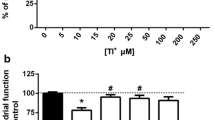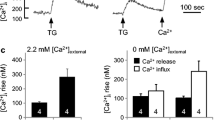Abstract
Recent studies from our laboratory indicate that polychlorinated biphenyl (PCB) congeners in vitro perturbed signal transduction mechanisms including cellular Ca2+-homeostasis and protein kinase C translocation. We have now investigated the structure-activity relationship (SAR) of three PCB mixtures, 24 PCB congeners and one dibenzofuran for their effects on microsomal and mitochondrial Ca2+-sequestration in rat cerebellum. Ca2+-sequestration by these intracellular organelles was determined using radioactive 45CaCl2. All three mixtures studied, Aroclor 1016, Aroclor 1254 and Aroclor 1260, were equally potent in inhibiting microsomal and mitochondrial Ca2+-sequestration with IC50 values of 6–8 μM. 1,2,3,7,8-Pentachlorodibenzofuran had no effect on Ca2+-sequestration by these organelles. The SAR among the congeners revealed: (1) congeners with ortho-/meta- or ortho-, para-chlorine substitutions were the most potent in inhibiting microsomal and mitochondrial Ca2+-sequestration (IC50=2.4–22.3 μM); (2) congeners with only para- but without ortho-substitutions were not effective in inhibiting Ca2+-sequestration by microsomes and mitochondria; (3) increased chlorination was not related to the effectiveness of these congeners. The present SAR studies indicate that the effects of most PCB congeners in vitro may be related to an interaction at specific sites having preference for low lateral substitution or lateral content (meta- or para) in the presence of ortho-substitution.
Similar content being viewed by others
References
Borle AB (1981) Control, modulation, and regulation of cell calcium. Rev Physiol Biochem Pharmacol 90: 13–153
carafoli E (1987) Intracellular calcium homeostasis. Annu Rev Biochem 56: 395–433
Choi DW (1985) Glutamate neurotoxicity in cortical cell culture is calcium dependent. Neurosci Lett 58: 293–297
Cottman CW, Matthews DA (1971) Synaptic plasma membranes from rat brain synaptosomes: Isolation and partial characterization. Biochem Biophys Acta 249: 380–394
Erickson MD (1986) Analytical chemistry of PCBs. Butterworth, Boston
Eboli ML, Ciotti MT, Mercanti D, Calissano P (1993) Differential involvement of protein kinase C in transmitter release and response to excitatory amino acids in cultured cerebellar neurons. Neurochem Res 18: 133–138
Fabiato A, Fabiato F (1978) Effect of pH on the myofilaments and the sarcoplasmic reticulum of skinned cells from cardiac and skeletal muscles. J Physiol 276: 233–255
Farber JL (1990) The role of calcium in lethal cell injury. Chem Res Toxicol 3: 503–508
Jensen S, Sundstrom G (1974) Structures and levels of most chlorobiphenyls in two technical PCB products and in human adipose tissue. Ambio 3: 70–76
Johnson JD, Meisenheimer TL, Isom GE (1986) Cyanide-induced neurotoxicity: role of neuronal calcium. Toxicol Appl Pharmacol 84: 464–469
Johnson JD, Conroy WG, Isom GE (1987) Alteration of cytosolic calcium levels in PC12 cells by potassium cyanide. Toxicol Appl Pharmacol 88: 217–224
Kiedrowski L, Costa E, Wroblewski JT (1992) Glutamate receptor agonists stimulate nitric oxide synthase in primary cultures of cerebellar granule cells. J Neurochem 58: 335–341
Kodavanti PRS, Shin D, Tilson HA, Harry GJ (1993) Comparative effects of two polychlorinated biphenyl congeners on Ca2+-homeostasis in rat cerebellar granule cells. Toxicol Appl Pharmacol 123: 97–106
Kodavanti PRS, Shafer TJ, Ward TR, Mundy WR, Freudenrich T, Harry GJ, Tilson HA (1994) Differential effects of polychlorinated biphenyl congeners on phosphoinositide hydrolysis and protein kinase C translocation in rat cerebellar granule cells. Brain Res 662: 75–82
Kodavanti PRS, Ward TR, McKinney JD, Tilson HA (1995) Increased [3H]-phorbol ester binding in rat cerebellar granule cells by polychlorinated biphenyl mixtures and congeners: structure-activity relationships. Toxicol Appl Pharmacol 130: 140–148
Kohli KK, Gupta BN, Albro PW, Mukhtar H, McKinney JD (1979) Biochemical effects of pure isomers of hexachlorobiphenyl: fatty livers and cell structure. Chem Biol Interact 25: 139–156
Kuratsune M, Youshimara T, Matsuzaka J, Yamaguchi A (1972) Epidemiologic study on Yusho: a poisoning caused by ingestion of rice oil contaminated with a commercial brand of polychlorinated biphenyls. Environ Health Perspect 1: 119–128
Kwan CY, Takemura H, Obie JF, Thastrup O, Putney JW Jr (1990) Effects of MeCh, thapsigargin, and La3+ on plasmalemmal and intracellular Ca2+ transport in lacrimal acinar cells. Am J Physiol 258: C1006-C1015
La Rocca PT, Carlson GP (1979) The effect of polychlorinated biphenyls on adenosine triphosphatase activity. Toxicol Appl Pharmacol 48: 185–192
Lowry OH, Rosebrough NJ, Farr AL, Randall RJ (1951) Protein measurement with folin-phenol reagent. J Biol Chem 193: 265–275.
Maier WE, Kodavanti PRS, Harry GJ, Tilson HA (1994) Sensitivity of adenosine triphosphatases in different brain regions to polychlorinated biphenyl congeners. J Appl Toxicol 14: 225–229
Matthews HB, Surles JR, Carver JG, Anderson MW (1984) Halogenated biphenyl transport by blood components. Fundam Appl Toxicol 4: 420–428
McKinney JD, Waller CL (1994) Polychlorinated biphenyls as hormonally active structure analogs. Environ Health Perspect 102: 290–297
McKinney JD, Chae K, Gupta BN, Moore JA, Goldstein JA (1976) Toxicological assessment of hexachlorobiphenyl isomers and 2,3,7,8-tetrachlorodibenzofuran in chicks. 1. Relationship of chemical parameters. Toxicol Appl Pharmacol 36: 65–80
Miller RJ (1991) The control of neuronal Ca2+-homeostasis. Prog Neurobiol 37: 255–285
Moore L, Chen T, Knapp HR Jr, Landon EL (1975) Energy dependent calcium sequestration activity in rat liver microsomes. J Biol Chem 250: 4562–4568
Nicotera P, Bellomo G, Orrenius S (1992) Calcium-mediated mechanisms in chemically induced cell death. Annu Rev Pharmacol Toxicol 32: 449–470
Nishihara Y, Utsumi K (1986) 2,5,2′,5′-Tetrachlorobiphenyl impairs the bioenergetic functions of isolated rat liver mitochondria. Biochem Pharmacol 35: 3335–3339
Nishihara Y, Robertson LW, Oesch F, Utsumi K (1985) Interaction of tetrachlorobiphenyls with isolated rat liver mitochondria. J Pharmacobio-Dyn 8: 726–732
Rosin DL, Martin BR (1981) Neurochemical and behavioral effects of polychlorinated biphenyls in mice. NeuroToxicology 2: 749–764
Safe S (1984) Polychlorinated biphenyls (PCBs) and polybrominated biphenyls (PBBs): biochemistry, toxicology, and mechanism of action. CRC Crit Rev Toxicol 12: 319–395
Safe L, Safe L, Mullin M (1987) Polychlorinated biphenyls: environmental occurrence and analysis, In: Safe S, Hutzinger O (eds) Polychlorinated biphenyls (PCBs): mammalian and environmental toxicology. Springer, Berlin, pp 1–13
SAS (1989) SAS/STAT users guide, vol. 2, GLM-VARCOMP. Version 6, 4th edn. SAS Institute, Cary, N.C.
Seegal RF, Brosch KO, Bush B (1986) Polychlorinated biphenyls produce regional alterations of dopamine metabolism in rat brain. Toxicol Lett 30: 197–202
Seegal RF, Bush B, Brosch KO (1991a) Sub-chronic exposure of the rat to Aroclor 1254 selectively alters central dopaminergic function. Neuro Toxicology 12: 55–66
Seegal RF, Bush B, Brosch KO (1991b) Comparison of effects of Aroclors 1016 and 1260 on non-human primate catecholamine function. Toxicology 66: 145–163
Shain W, Overmann SR, Wilson LR, Kostas J, Bush B (1986) A congener analysis of polychlorinated biphenyls accumulating in rat pups after perinatal exposure. Arch Environ Contam Toxicol 15: 687–707
Shain W, Bush B, Seegal R (1991) Neurotoxicity of polychlorinated biphenyls: structure-activity relationship of individual congeners. Toxicol Appl Pharmacol 111: 33–42
Siesjo BK (1990) Calcium in the brain under physiological and pathological conditions. Eur Neurol 30 [Suppl 2]: 3–9
Waller CL, McKinney JD (1992) Comparative molecular field analysis of the polyhalogenated dibenzo-p-dioxins, dibenzofurans, and biphenyls. J Med Chem 35: 3660–3666
World Health Organization (1993) Environmental Health Criteria 140: polychlorinated biphenyls and terphenyls (2nd edn), prepared by Drs. S. Dobson and G.J. van Esch. International Programme on Chemical Safety, Geneva, Switzerland
Zimmerman U-J P, Schlaepfer WW (1982) Characterization of a brain calcium-activated protease that degrades neurofilament proteins. Biochemistry 21: 3977–3983.
Author information
Authors and Affiliations
Rights and permissions
About this article
Cite this article
Kodavanti, P.R.S., Ward, T.R., McKinney, J.D. et al. Inhibition of microsomal and mitochondrial Ca2+-sequestration in rat cerebellum by polychlorinated biphenyl mixtures and congeners. Arch Toxicol 70, 150–157 (1996). https://doi.org/10.1007/s002040050254
Received:
Accepted:
Issue Date:
DOI: https://doi.org/10.1007/s002040050254




